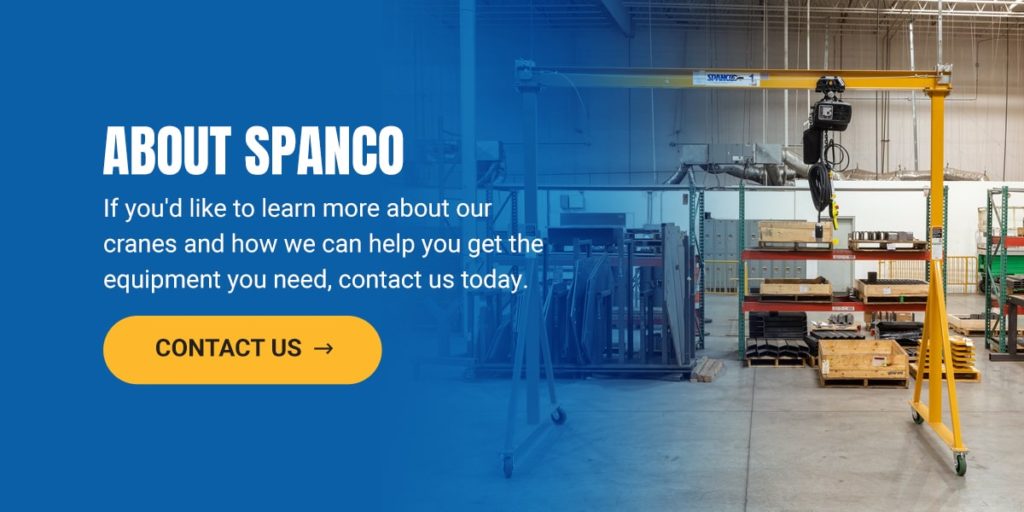
A Brief Guide to Crane Maintenance
May 11, 2023

A preventative maintenance program is critical if your company uses an overhead crane for material handling. Be sure to center your maintenance program on an effective, thorough, and regularly conducted safety inspection plan. If your crane inspector finds any unsafe conditions or deteriorated components, you must repair them before any work can continue using the crane.
In order to implement a proper and thorough preventative maintenance program, you must first consider a daily inspection and safety procedure checklist. Following a checklist to ensure your overhead crane is receiving proper maintenance will not only allow you to keep your system in working order for much longer, but it will also preserve your warranty and prevent potential worker safety concerns from arising.
The Importance of Crane Inspections and Maintenance
Crane inspections and regular maintenance are important for a host of reasons. Here are some of the main benefits your company will experience from consistent inspections and preventative crane maintenance:
- Increased dependability: You depend on your crane to complete a variety of work duties. Having a proper maintenance and inspection routine ensures your cranes work when you need them, time after time.
- Asset protection and longevity: Your company has invested a lot of money in its cranes. In fact, they may be one of your biggest assets, helping you meet the needs of your clients and getting your work done every day. Protect your assets and ensure greater longevity by properly inspecting and maintaining your cranes. Preventative maintenance goes a long way toward ensuring your cranes do not have major issues in the future.
- Greater employee safety: The safety of your employees is of the utmost priority, whether they’re using mobile cranes, stationary cranes, or cranes lifting heavy machinery and equipment. By staying consistent with inspections and maintenance, you take measures to ensure your employees stay safe while operating or working around cranes.
- OSHA compliance: OSHA has several regulations regarding crane inspections and maintenance. Ensure your company is OSHA-compliant by keeping up with your maintenance and inspection schedule.

Daily Inspection Checklist for Overhead Cranes
After ensuring the area is clear of hazards and the crane is de-energized, a qualified individual can use the following checklist to conduct a proper daily inspection for an overhead crane:
- Ensure proper alignment: Cranes can go out of alignment after extended periods of use and start leaning to a particular side. Visually inspect the crane to determine whether it has fallen out of alignment.
- Inspect chains and connections for damage: Inspectors should look for signs of rust, damage, and other forms of serious wear on the chains and connections that make up the hoist.
- Ensure the hook is intact: Inspect the hook for bends or cracks. The hook is essential for lifting heavy loads, and damaged hooks can pose a serious safety risk if left unaddressed.
- Check hydraulic and air systems: Your crane’s hydraulic and air systems are crucial to its functionality. Check all lines, pipes, and other parts, remembering that many of these components are more susceptible to damage than the crane’s metal components.
- Replace wheels as needed: If your crane has wheels, replace them as soon as you notice any signs of wear or outright damage.
Proper Record Keeping for Crane Maintenance and Inspection
Proper record keeping is essential when it comes to maintaining and inspecting your cranes. Having the right documents on hand makes it easy to see your crane’s maintenance history, both for your company’s personal use and in the event of an audit.
Here are some examples of the type of information you should include in your maintenance and inspection record reports:
- The dates of maintenance and inspection
- The name of the mechanic who performed maintenance or the qualified person who conducted the inspection
- The replaced components
- The type of work completed
- Any noticed signs of irregularities or damage
- The signature of work completed
- The inspected parts and components
- The method of the inspection along with the criteria used
- Photographs and measurements from the inspection
- Official recommendations for maintenance or repair work upon completion of the inspection
Practice proper record keeping, ensuring you keep your records organized in a safe, accessible location.

About SPANCO
SPANCO has spent over four decades providing high-quality material handling solutions that meet your needs and budget. We put safety first every day, and it shows in the quality of our products.
If you’d like to learn more about our cranes and how we can help you get the equipment you need, contact us today.
Categories
Share this post
Contact us
Looking for the perfect fall protection equipment? Let us help!
